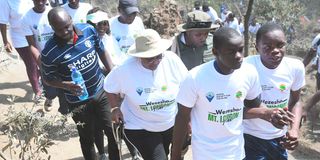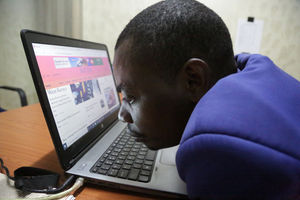‘My unique hiking experience with blind students’

Some of the participants of the blind hike at the base of Mt Longonot on September 23.
What you need to know:
- I found out from James Kago, the head of Human Resources and Operations at the Kenya Society for the Blind, that all 400 students at the Thika School for the Blind share 40 braille machines, seven of which are broken.
- This would mean that when it’s time for them to sit the Kenya Certificate of Primary Education exams on October 30, they will have to do it in turns.
“As a journalist, I have embarked on countless adventures in pursuit of unique stories, but none could have prepared me for my first-ever hiking expedition to Mt Longonot National Park alongside visually impaired students, who dared to break the barriers their bodies have set for them.
On the morning of September 23,, I arrived at Kencom bus station in Nairobi and met a group of cheerful people, identifying their friends just by their voices. While they were bubbling with excitement, my mind was bursting with questions. I wondered how one would hike without seeing. “What if they get injured? How does it feel to rely on and trust someone else for an activity as treacherous as hiking?” I wondered.
By 10am, we had gathered under the shadow of the dormant giant, donning white tee shirts whose backs read “Climbing for the blind.” The event had been organised by the Kenya Society for the Blind, and we were hiking as friends of the society.
While I thought about the worst possible scenarios that were likely to happen, I marvelled at their mental strength and resilience. While it was my first hiking expedition, they had done this before — as an annual charity event — to raise awareness on the challenges faced by blind students and raise funds to support people with visual impairment. This time they would be flagged off by Dorcas Rigathi, the spouse of Deputy President Rigathi Gachagua.
But first, a speech under a tent, where I found out from James Kago, the head of Human Resources and Operations at the Kenya Society for the Blind, that all 400 students at the Thika School for the Blind share 40 braille machines, seven of which are broken. This would mean that when it’s time for them to sit the Kenya Certificate of Primary Education exams on October 30, they will have to do it in turns.
Sammy Waweru, the Society’s executive director, called the activity a worthy cause, noting that the first thing one thinks about when disability is mentioned is a person who is physically impaired.
“We are here for a worthy cause in that visually impaired people, despite the abilities they have been given, we are only judged because of lacking one sense, the sense of sight. But visually impaired people, I assure you, always see. And it is not them who are blind, rather it’s us as a community who are blind to how they can be supported to thrive,” he said.
“Learning for students with visual impairment is at the centre of everything we do. If we don’t empower them with devices, resources, qualified teachers and enable them to get quality education, we will not achieve the sustainable development goal of leaving no one behind. “
He noted that according to the latest census, there are 334,000 totally blind persons and 750,000 partially blind in the country.
Ms Rigathi urged the society to be careful lest they fail to see, feel and touch the lives of the visually impaired in a special way
“We gave birth to these children and what they need is an enabling environment. Every step we make up the mountain is symbolic of the heights we can achieve when we come together hand in hand to support those who face unique challenges in life. It reminds us that it is not just a step up the mountain, but a step towards an inclusive and more compassionate system. Because if we love one another, we will not harm one another,” she said.
“This climb is an embodiment of our commitment to an equal society where nobody is left behind, it is also our demonstration of our belief that every person, regardless of visual ability, deserves access to education, employment and opportunities that life can offer.”
With sturdy hiking boots and an unyielding spirit, we set forth on the rugged path that led up the steep slopes. Mt Longonot's trail was no ordinary walk in the park; it was a challenging ascent, filled with loose volcanic scree and daunting inclines. The blind hikers navigated this treacherous terrain with unwavering resolve, their trust in their fellow hikers and their own capabilities pushing them forward.
As we ascended, I couldn't help but notice the hikers' profound connection to the environment. They relied on senses – touch, hearing and smell - I often took for granted. And even though some tripped and fell, they kept climbing, eager to reach the mountain’s summit.
Gasping for breath but brimming with determination, we reached the crater's rim. As we peered into the abyss, I was reminded that even without sight, one could still appreciate nature's beauty.
The descent was a reflective journey, filled with lessons on resilience, determination and the indomitable human spirit. We left Mt Longonot with a profound appreciation for the blind hikers, who had demonstrated that limitations exist only in the mind and that nature's beauty is not confined to what the eye can see.
In the end, our climb was not just about reaching the summit; it was about challenging preconceptions, embracing diversity, and experiencing the world in a way that transcends physical sight. It was a story of triumph, unity, and the heights of imagination reached by those who dare to defy expectations.





